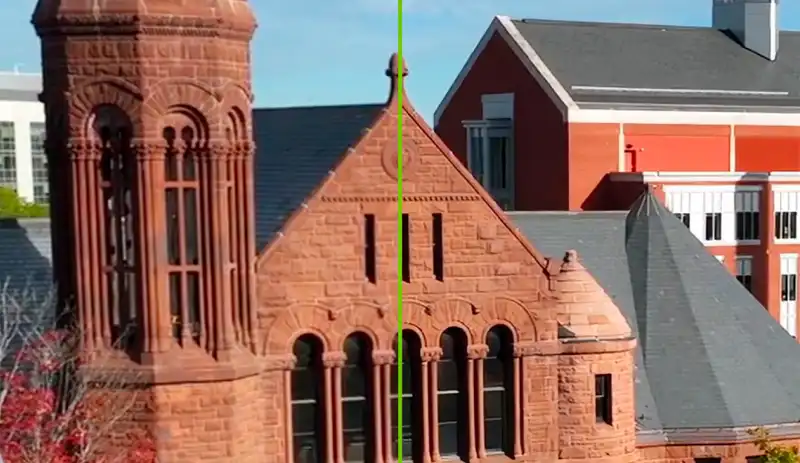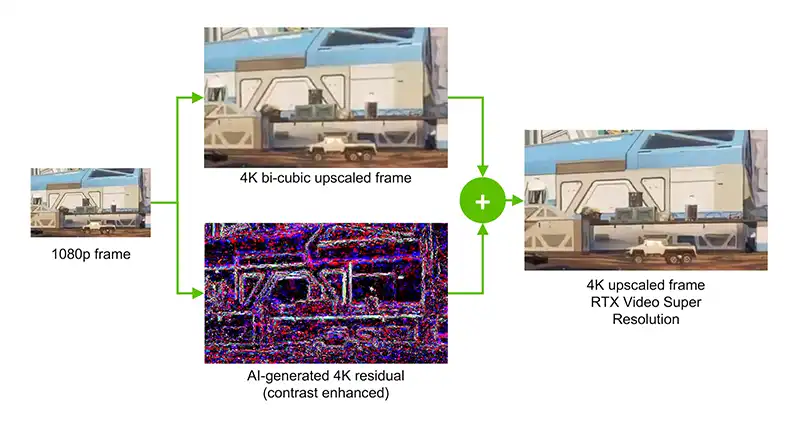You can also be interested in these:
- What is a 3D XPoint DIMM?
- What are OP and Opal technologies on SSDs?
- How to remove the metadata from image files
- Is your new laptop second hand? Let’s find out
Nvidia continues to develop new features to improve the user’s graphic experience, and the latest addition is called RTX Video Super Resolution. This image upscaling function is based on the well-known DLSS technology that is specific to games. However, Nvidia’s RTX 30 and 40 graphics cards’ Tensor cores are also utilized to develop the AI that will enable video streaming to be upscaled to a higher quality on popular browsers and on 1440p or 2160p monitors. This feature will improve the video streaming experience for users with lower-resolution displays.
What is the Nvidia RTX Video Super Resolution?
Nvidia’s RTX Video Super Resolution technology is capable of improving the quality of streaming or real-time videos using AI-based upscaling techniques. This means that the technology takes the video in the resolution being transmitted, for example, 1080p or even 480p, and upscales it to the native resolution of the user’s monitor.

The process is carried out through the Tensor cores of Nvidia graphics cards and is currently only compatible with Nvidia RTX 30 and RTX 40, excluding RTX 20, even though they also have Tensor cores. This feature will be directly implemented in Nvidia’s GeForce Game Ready drivers starting from version 531.14. It will have four quality levels, with each increasing the graphics resource consumption slightly. The technology will significantly improve the video viewing experience for users with low-resolution displays.
Nvidia RTX Video Super Resolution will be compatible with Google Chrome from version 110.0.5481.105 and Chromium-based Microsoft Edge from version 110.0.1587.56. Users can use it with major video streaming platforms such as YouTube, Disney+, Netflix, Prime Video, Hulu, and Twitch.tv, which is one of the most popular networks today, where most streams are at 1080p. However, it supports resolutions ranging from 360p to 1440p.
The purpose of RTX Video Super Resolution is processing streaming videos, removing the artifacts generated due to network compression, thereby improving the image’s sharpness and clarity. This feature will be particularly useful for users who have a monitor with a higher resolution than the video’s native resolution to improve the upscaling quality. It will also be useful for users with lower bandwidth connections, enabling them to view content at, for example, 720p on a 1080p or higher monitor. Overall, the technology significantly enhances the video streaming experience for users.
How to activate Nvidia RTX Video Super Resolution?
To activate RTX VSR, users need an Nvidia RTX 40 or 30 graphics card, with Game Ready drivers version 531.14 or higher installed, along with updated compatible browsers.
Once the drivers are installed, users can open the Nvidia Control Panel from the taskbar icon or by right-clicking on the desktop and accessing it. Then, go to the “Adjust video image settings” and on the right-hand side, users will find the new option “RTX Video Enhancement”.
After opening the Nvidia Control Panel and going to “Adjust video image settings,” users can activate RTX Video Enhancement by checking the box. The feature has four quality levels to choose from, allowing users to select the one that suits them best. Then, users can apply the settings to activate the feature.

If users are already streaming a video through their browser, it is recommended to reload the video to apply the algorithm’s effect. Alternatively, users can close and reopen the browser to enable the feature.
Conclusion on the Nvidia RTX Video Super Resolution
In this first version of RTX Video Super Resolution, the technology offers minor improvements in texture sharpness and detail, but it does not significantly change the video’s quality, particularly when streaming moving videos at 1080p and upscaling to 2160p. However, it shows more potential for real-time streaming, such as on Twitch, where it compensates better for low bitrates, enhancing image sharpness and smoothing edges.
As previously mentioned, adding frame generation to the algorithm, like in DLSS 3, could make a significant difference, improving video fluidity and eliminating minor lags in some streams, particularly when experiencing high ping.
RTX VSR is another step forward for Nvidia to bring the performance and image quality of native high-resolution content closer to compressed streaming content, which is inherently limited in this aspect. The feature will receive further improvements and optimizations in subsequent versions, providing a promising future for it. In the near future, it may become indispensable for low-bandwidth connections or lower-resolution videos.
More stories like this
- What is a 3D XPoint DIMM?
- What are OP and Opal technologies on SSDs?
- How to remove the metadata from image files
- Is your new laptop second hand? Let’s find out
- How to configure the BIOS to optimize your PC
- CPU over temperature error: Causes and fixes
